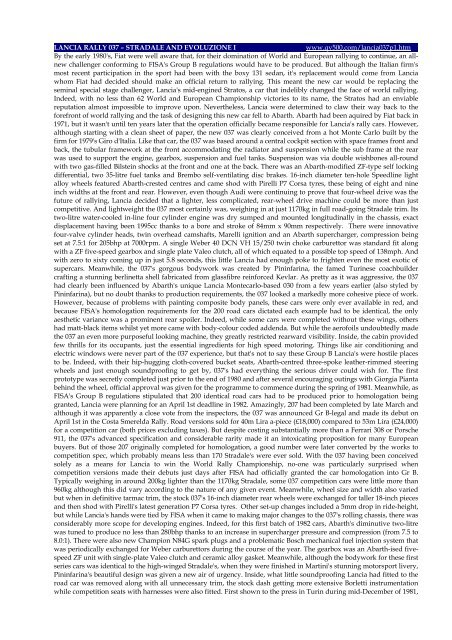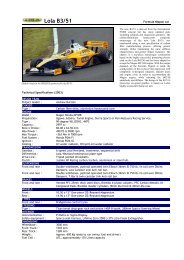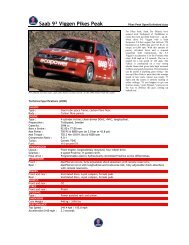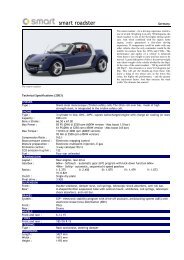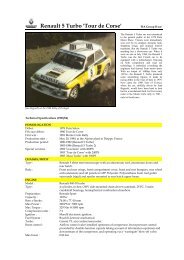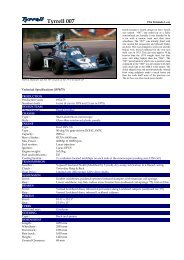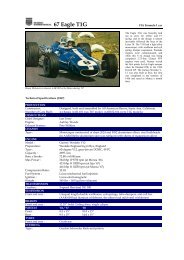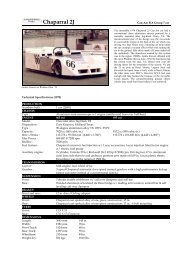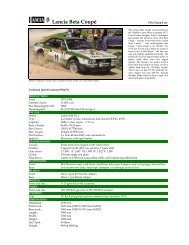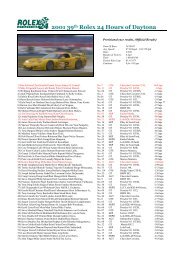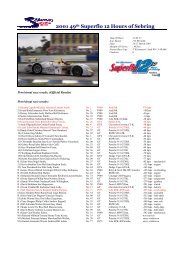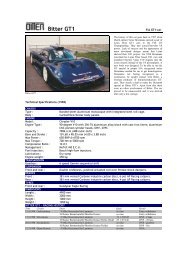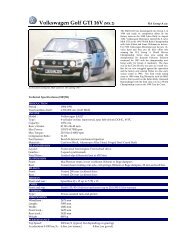83 Lancia Rally 037 - Motorsports Almanac
83 Lancia Rally 037 - Motorsports Almanac
83 Lancia Rally 037 - Motorsports Almanac
You also want an ePaper? Increase the reach of your titles
YUMPU automatically turns print PDFs into web optimized ePapers that Google loves.
LANCIA RALLY <strong>037</strong> – STRADALE AND EVOLUZIONE I www.qv500.com/lancia<strong>037</strong>p1.htm<br />
By the early 1980's, Fiat were well aware that, for their domination of World and European rallying to continue, an allnew<br />
challenger conforming to FISA's Group B regulations would have to be produced. But although the Italian firm's<br />
most recent participation in the sport had been with the boxy 131 sedan, it's replacement would come from <strong>Lancia</strong><br />
whom Fiat had decided should make an official return to rallying. This meant the new car would be replacing the<br />
seminal special stage challenger, <strong>Lancia</strong>'s mid-engined Stratos, a car that indelibly changed the face of world rallying.<br />
Indeed, with no less than 62 World and European Championship victories to its name, the Stratos had an enviable<br />
reputation almost impossible to improve upon. Nevertheless, <strong>Lancia</strong> were determined to claw their way back to the<br />
forefront of world rallying and the task of designing this new car fell to Abarth. Abarth had been aquired by Fiat back in<br />
1971, but it wasn't until ten years later that the operation officially became responsible for <strong>Lancia</strong>'s rally cars. However,<br />
although starting with a clean sheet of paper, the new <strong>037</strong> was clearly conceived from a hot Monte Carlo built by the<br />
firm for 1979's Giro d'Italia. Like that car, the <strong>037</strong> was based around a central cockpit section with space frames front and<br />
back, the tubular framework at the front accommodating the radiator and suspension while the sub frame at the rear<br />
was used to support the engine, gearbox, suspension and fuel tanks. Suspension was via double wishbones all-round<br />
with two gas-filled Bilstein shocks at the front and one at the back. There was an Abarth-modified ZF-type self locking<br />
differential, two 35-litre fuel tanks and Brembo self-ventilating disc brakes. 16-inch diameter ten-hole Speedline light<br />
alloy wheels featured Abarth-crested centres and came shod with Pirelli P7 Corsa tyres, these being of eight and nine<br />
inch widths at the front and rear. However, even though Audi were continuing to prove that four-wheel drive was the<br />
future of rallying, <strong>Lancia</strong> decided that a lighter, less complicated, rear-wheel drive machine could be more than just<br />
competitive. And lightweight the <strong>037</strong> most certainly was, weighing in at just 1170kg in full road-going Stradale trim. Its<br />
two-litre water-cooled in-line four cylinder engine was dry sumped and mounted longitudinally in the chassis, exact<br />
displacement having been 1995cc thanks to a bore and stroke of 84mm x 90mm respectively. There were innovative<br />
four-valve cylinder heads, twin overhead camshafts, Marelli ignition and an Abarth supercharger, compression being<br />
set at 7.5:1 for 205bhp at 7000rpm. A single Weber 40 DCN VH 15/250 twin choke carburettor was standard fit along<br />
with a ZF five-speed gearbox and single plate Valeo clutch, all of which equated to a possible top speed of 138mph. And<br />
with zero to sixty coming up in just 5.8 seconds, this little <strong>Lancia</strong> had enough poke to frighten even the most exotic of<br />
supercars. Meanwhile, the <strong>037</strong>'s gorgous bodywork was created by Pininfarina, the famed Turinese coachbuilder<br />
crafting a stunning berlinetta shell fabricated from glassfibre reinforced Kevlar. As pretty as it was aggressive, the <strong>037</strong><br />
had clearly been influenced by Abarth's unique <strong>Lancia</strong> Montecarlo-based 030 from a few years earlier (also styled by<br />
Pininfarina), but no doubt thanks to production requirements, the <strong>037</strong> looked a markedly more cohesive piece of work.<br />
However, because of problems with painting composite body panels, these cars were only ever available in red, and<br />
because FISA's homologation requirements for the 200 road cars dictated each example had to be identical, the only<br />
aesthetic variance was a prominent rear spoiler. Indeed, while some cars were completed without these wings, others<br />
had matt-black items whilst yet more came with body-colour coded addenda. But while the aerofoils undoubtedly made<br />
the <strong>037</strong> an even more purposeful looking machine, they greatly restricted rearward visibility. Inside, the cabin provided<br />
few thrills for its occupants, just the essential ingredients for high speed motoring. Things like air conditioning and<br />
electric windows were never part of the <strong>037</strong> experience, but that's not to say these Group B <strong>Lancia</strong>'s were hostile places<br />
to be. Indeed, with their hip-hugging cloth-covered bucket seats, Abarth-centred three-spoke leather-rimmed steering<br />
wheels and just enough soundproofing to get by, <strong>037</strong>'s had everything the serious driver could wish for. The first<br />
prototype was secretly completed just prior to the end of 1980 and after several encouraging outings with Giorgia Pianta<br />
behind the wheel, official approval was given for the programme to commence during the spring of 1981. Meanwhile, as<br />
FISA's Group B regulations stipulated that 200 identical road cars had to be produced prior to homologation being<br />
granted, <strong>Lancia</strong> were planning for an April 1st deadline in 1982. Amazingly, 207 had been completed by late March and<br />
although it was apparently a close vote from the inspectors, the <strong>037</strong> was announced Gr B-legal and made its debut on<br />
April 1st in the Costa Smerelda <strong>Rally</strong>. Road versions sold for 40m Lira a-piece (£18,000) compared to 53m Lira (£24,000)<br />
for a competition car (both prices excluding taxes). But despite costing substantially more than a Ferrari 308 or Porsche<br />
911, the <strong>037</strong>'s advanced specification and considerable rarity made it an intoxicating proposition for many European<br />
buyers. But of those 207 originally completed for homologation, a good number were later converted by the works to<br />
competition spec, which probably means less than 170 Stradale's were ever sold. With the <strong>037</strong> having been conceived<br />
solely as a means for <strong>Lancia</strong> to win the World <strong>Rally</strong> Championship, no-one was particularly surprised when<br />
competition versions made their debuts just days after FISA had officially granted the car homologation into Gr B.<br />
Typically weighing in around 200kg lighter than the 1170kg Stradale, some <strong>037</strong> competition cars were little more than<br />
960kg although this did vary according to the nature of any given event. Meanwhile, wheel size and width also varied<br />
but when in definitive tarmac trim, the stock <strong>037</strong>'s 16-inch diameter rear wheels were exchanged for taller 18-inch pieces<br />
and then shod with Pirelli's latest generation P7 Corsa tyres. Other set-up changes included a 5mm drop in ride-height,<br />
but while <strong>Lancia</strong>'s hands were tied by FISA when it came to making major changes to the <strong>037</strong>'s rolling chassis, there was<br />
considerably more scope for developing engines. Indeed, for this first batch of 1982 cars, Abarth's diminutive two-litre<br />
was tuned to produce no less than 280bhp thanks to an increase in supercharger pressure and compression (from 7.5 to<br />
8.0:1). There were also new Champion N84G spark plugs and a problematic Bosch mechanical fuel injection system that<br />
was periodically exchanged for Weber carburettors during the course of the year. The gearbox was an Abarth-ised fivespeed<br />
ZF unit with single-plate Valeo clutch and ceramic alloy gasket. Meanwhile, although the bodywork for these first<br />
series cars was identical to the high-winged Stradale's, when they were finished in Martini's stunning motorsport livery,<br />
Pininfarina's beautiful design was given a new air of urgency. Inside, what little soundproofing <strong>Lancia</strong> had fitted to the<br />
road car was removed along with all unnecessary trim, the stock dash getting more extensive Borletti instrumentation<br />
while competition seats with harnesses were also fitted. First shown to the press in Turin during mid-December of 1981,


